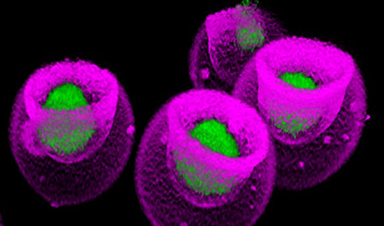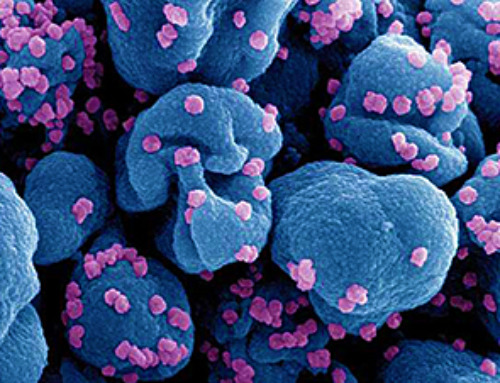A recent UCLA study demonstrates a new process for screening T cells, part of the body’s natural defenses, for characteristics vital to the success of cell-based treatments. The method filters T cells based on the receptor proteins found on their surface—which enable them to latch onto certain threats—and the type and amount of cell-killing or immune response-triggering molecules that they secrete.
The research is published in the journal Proceedings of the National Academy of Sciences.
The researchers discovered three previously unidentified, naturally occurring T-cell receptors that target prostate cancer using their screening method. In validation tests, T-cell receptors associated with the highest levels of secretion were the most likely to elicit a response against cancer cells. Rate of functional T-cell receptors was around tenfold higher than using previous techniques.
Immunotherapy, treatment that harnesses the body’s natural defenses, is an ever-growing subject of research into cancer and other severe illnesses. The potential of engineered T cell-based immunotherapies comes in part from their ability to narrowly target signatures of disease that are “recognized” by genetically engineered receptors. Since 2017, seven therapies deploying immune cells have gained approval from the Food and Drug Administration to treat blood and skin cancers.
The scientists used nanovials, microscopic bowl-shaped hydrogel containers developed at UCLA. Inside, the containers are customized to include specially shaped molecules that enable each to trap one cell plus selected secretions.
The team first evaluated a population of 20 million T cells sourced from one healthy patient’s blood sample. Different groups of nanovials had targets associated with different common viruses. This study validated the ability for nanovials to find T cells, and their receptors, that react to viruses.
A second experiment with a different patient applied the technology to a much more challenging problem: rare prostate cancer targets the scientists had identified in previous studies. Importantly, those molecular targets acted to both capture the T cells and cause them to secrete certain molecules that kill target cells. In other experiments, the nanovials also had molecules allowing each to capture more than one type of immune-activating secretion.
The three never-before-seen receptors for prostate cancer found in this research could ultimately lead to new tumor-fighting immunotherapies. The ability to select T cells that both bind to a disease-related target and secrete plenty of molecules that trigger an immune response—displayed in the study—is expected to provide major advantages for uncovering additional new disease-targeting receptors, developing cellular therapies and translating those therapies to benefit patients. Using standard lab techniques to label and analyze the nanovials and their contents means that more researchers can apply the new technique.
More information: Doyeon Koo et al, Defining T cell receptor repertoires using nanovial-based binding and functional screening, Proceedings of the National Academy of Sciences (2024). DOI: 10.1073/pnas.2320442121
Journal information: Proceedings of the National Academy of Sciences
Provided by University of California, Los Angeles
News
Older chemical libraries show promise for fighting resistant strains of COVID-19 virus
SARS‑CoV‑2, the virus that causes COVID-19, continues to mutate, with some newer strains becoming less responsive to current antiviral treatments like Paxlovid. Now, University of California San Diego scientists and an international team of [...]
Lower doses of immunotherapy for skin cancer give better results, study suggests
According to a new study, lower doses of approved immunotherapy for malignant melanoma can give better results against tumors, while reducing side effects. This is reported by researchers at Karolinska Institutet in the Journal of the National [...]
Researchers highlight five pathways through which microplastics can harm the brain
Microplastics could be fueling neurodegenerative diseases like Alzheimer's and Parkinson's, with a new study highlighting five ways microplastics can trigger inflammation and damage in the brain. More than 57 million people live with dementia, [...]
Tiny Metal Nanodots Obliterate Cancer Cells While Largely Sparing Healthy Tissue
Scientists have developed tiny metal-oxide particles that push cancer cells past their stress limits while sparing healthy tissue. An international team led by RMIT University has developed tiny particles called nanodots, crafted from a metallic compound, [...]
Gold Nanoclusters Could Supercharge Quantum Computers
Researchers found that gold “super atoms” can behave like the atoms in top-tier quantum systems—only far easier to scale. These tiny clusters can be customized at the molecular level, offering a powerful, tunable foundation [...]
A single shot of HPV vaccine may be enough to fight cervical cancer, study finds
WASHINGTON -- A single HPV vaccination appears just as effective as two doses at preventing the viral infection that causes cervical cancer, researchers reported Wednesday. HPV, or human papillomavirus, is very common and spread [...]
New technique overcomes technological barrier in 3D brain imaging
Scientists at the Swiss Light Source SLS have succeeded in mapping a piece of brain tissue in 3D at unprecedented resolution using X-rays, non-destructively. The breakthrough overcomes a long-standing technological barrier that had limited [...]
Scientists Uncover Hidden Blood Pattern in Long COVID
Researchers found persistent microclot and NET structures in Long COVID blood that may explain long-lasting symptoms. Researchers examining Long COVID have identified a structural connection between circulating microclots and neutrophil extracellular traps (NETs). The [...]
This Cellular Trick Helps Cancer Spread, but Could Also Stop It
Groups of normal cbiells can sense far into their surroundings, helping explain cancer cell migration. Understanding this ability could lead to new ways to limit tumor spread. The tale of the princess and the [...]
New mRNA therapy targets drug-resistant pneumonia
Bacteria that multiply on surfaces are a major headache in health care when they gain a foothold on, for example, implants or in catheters. Researchers at Chalmers University of Technology in Sweden have found [...]
Current Heart Health Guidelines Are Failing To Catch a Deadly Genetic Killer
New research reveals that standard screening misses most people with a common inherited cholesterol disorder. A Mayo Clinic study reports that current genetic screening guidelines overlook most people who have familial hypercholesterolemia, an inherited disorder that [...]
Scientists Identify the Evolutionary “Purpose” of Consciousness
Summary: Researchers at Ruhr University Bochum explore why consciousness evolved and why different species developed it in distinct ways. By comparing humans with birds, they show that complex awareness may arise through different neural architectures yet [...]
Novel mRNA therapy curbs antibiotic-resistant infections in preclinical lung models
Researchers at the Icahn School of Medicine at Mount Sinai and collaborators have reported early success with a novel mRNA-based therapy designed to combat antibiotic-resistant bacteria. The findings, published in Nature Biotechnology, show that in [...]
New skin-permeable polymer delivers insulin without needles
A breakthrough zwitterionic polymer slips through the skin’s toughest barriers, carrying insulin deep into tissue and normalizing blood sugar, offering patients a painless alternative to daily injections. A recent study published in the journal Nature examines [...]
Multifunctional Nanogels: A Breakthrough in Antibacterial Strategies
Antibiotic resistance is a growing concern - from human health to crop survival. A new study successfully uses nanogels to target and almost entirely inhibit the bacteria P. Aeruginosa. Recently published in Angewandte Chemie, the study [...]
Nanoflowers rejuvenate old and damaged human cells by replacing their mitochondria
Biomedical researchers at Texas A&M University may have discovered a way to stop or even reverse the decline of cellular energy production—a finding that could have revolutionary effects across medicine. Dr. Akhilesh K. Gaharwar [...]





















